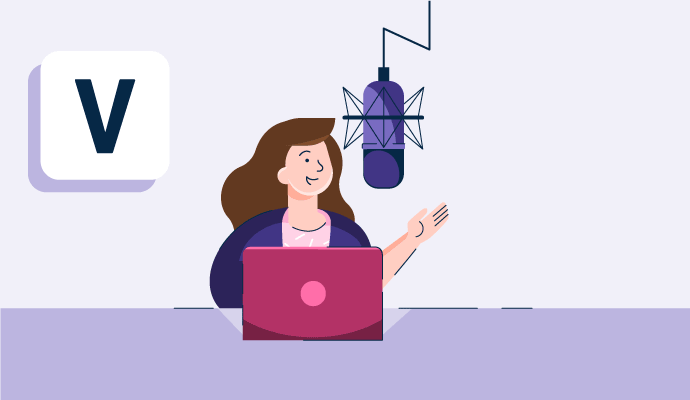What is a voiceover?
A voiceover is a production technique commonly used in the film and broadcast industries, where a voice is recorded and added to a video or audio recording. Typically, production uses voicers to provide commentary, narration, or character dialogue to fill in gaps in the story or convey information to the audience. Those specializing in voiceover production are called voice actors or narrators.
Businesses may use text to speech software to add synthesized voiceovers to their websites and applications via an API. Text to speech software allows users to customize different aspects of the voice, including the pitch, volume, and emotion.
Types of voiceovers
Production specialists and media businesses may use voiceovers across various projects. The most common types of projects where voiceovers appear include:
- Audiobooks: Authors and book publishers rely on voiceovers to create an audio version of a book and read it aloud to listeners. Sometimes, authors are the voice actors for their books, but other times, they outsource the reading to someone else.
- Character voices: In animated films and cartoons, voiceovers bring characters to life, giving them personality and the ability to interact with one another.
- Commercials: Television producers and brands frequently leverage voiceovers in commercials to deliver an advertisement or provide narration on top of the visual content. Commercial voiceovers usually use emotional or persuasive tones to encourage purchases.
- E-learning materials: Businesses can use voiceovers for e-learning materials to enhance the quality and effectiveness of their training content. Audio helps make content more interactive and engaging and helps meet the needs of different learning styles.
- Narration: Some motion pictures and movie trailers include voiceover narration to help tell a story from a character's perspective or a third-party viewer. This voiceover category adds depth and details to what viewers see on screen and often fills in details that might otherwise be missing without the narrated commentary.
- Radio broadcasts: Similar to television commercials, radio programs often use voiceovers for announcements, hosts, and special segments.
- Video games: Voiceovers are common in the video game industry as voice actors often provide voices for in-game characters and narrative storytelling. In addition to voiceovers, some voice actors provide body movements for motion capture and performance.
Benefits of text-to-speech voiceovers
In general, voiceovers offer many benefits to businesses that leverage them. Some of the undeniable benefits of text to speech voiceovers include the following:
- Greater accessibility: Direct voiceover content, such as reading a book aloud, provides accessibility to the content for individuals with reading difficulties or visual impairments. Voiceovers are a great way to expand text-based content to be more inclusive and reach a diverse audience.
- Voice consistency: Text to speech software can provide consistent pronunciation and audio content delivery. While voice actors can develop their skills to enhance consistency, text-to-speech recordings reduce the risks of human errors and unwanted variations.
- Potential cost savings: Hiring voice actors ad hoc for projects can be costly. Text to speech software eliminates the need to pay for voiceover services while equipping an organization with an in-house tool for content creation.
- Selection of appealing voices: Finding the right voice actor for a specific project can be challenging. One significant benefit of text to speech voiceovers is that businesses can save time searching for and interviewing voice actors as the systems provide voices to leverage and customize. Rather than find a voice that is pleasant to listen to, producers can create one.
Best practices to make an excellent voiceover
While creating a voiceover may seem simple, some traits help voice recordings stand out. Successful and effective voiceovers possess the following characteristics:
- Voice quality: Although it might seem obvious, a good voiceover should be pleasant and memorable for listeners. While an individual’s voice may not appeal to all listeners, working with a voice actor who will satisfy a general audience is essential.
- Clear diction and articulation: A good voiceover, whether recorded by a voice actor or synthesized, must be clear to ensure the audience can understand the spoken content. Clear diction consists of pronunciation and clarity. Voice actors can improve enunciation by practicing tongue twisters and reading content aloud.
- Expressions and emotion: Voice actors must be able to convey a range of emotions to listeners through their voices. Tone, pitch, and voice inflections can help voice actors get the point across and connect with listeners on a deeper level.
- Proper pacing and timing: Delivering a script effectively requires good pacing and timing. Voice actors and narrators need a decent sense of rhythm and an ability to match their delivery to the pacing of the content.
- Effective breath control: Voice actors must have effective breath control to maintain uninterrupted and precise script delivery. Taking a breath mid-sentence can be distracting and lead to an unclear message. Voice actors and narrators can develop their breath control by practicing breathing techniques and reciting content aloud.
Keep reading to learn more about natural language processing (NLP) and its applications.

Alyssa Towns
Alyssa Towns works in communications and change management and is a freelance writer for G2. She mainly writes SaaS, productivity, and career-adjacent content. In her spare time, Alyssa is either enjoying a new restaurant with her husband, playing with her Bengal cats Yeti and Yowie, adventuring outdoors, or reading a book from her TBR list.

